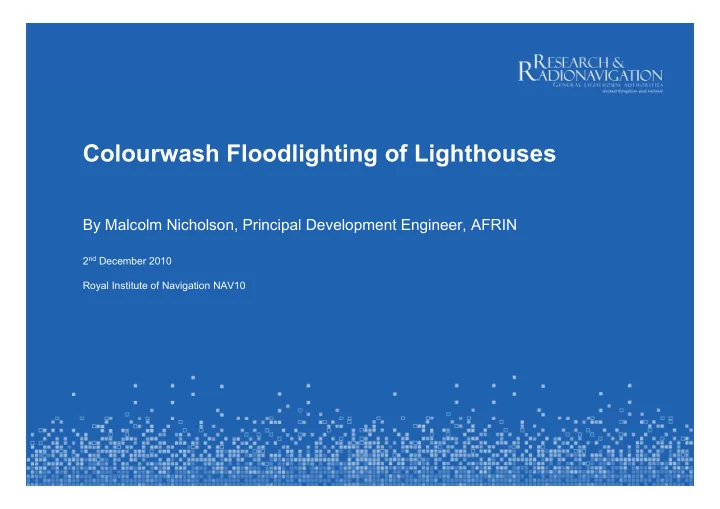

Colourwash Floodlighting of Lighthouses By Malcolm Nicholson, Principal Development Engineer, AFRIN 2 nd December 2010 Royal Institute of Navigation NAV10
Introduction � Use of modern Radionavigation Technology � Growth in Coastal Background Lighting � The GLA’s require a method to provide a quick visual confirmation � One method is to colour-wash or floodlight the existing structure � In order to – � Determine the most effective colour � Determine the most effective geometry � Determine the required illumination
Methods - Colour � Initial feasibility studies indicated that colour contrast was the dominant factor � Six 200W RGB LED Floodlights were used Floodlight Software setting to achieve colours (%) Colour R G B Blue 0 0 100 Orange 50 100 0 Green 0 100 0 Cyan 0 100 100 Magenta 100 0 100 Yellow 100 50 0 White 100 100 100 Red 100 0 0
Methods - Geometry � Three down lighters angled at 50 o at 1.5m � Three up lighters angled at 45 o at 3m
Method - Illumination � Three trials � First trial ¼ intensity � Second trial ½ intensity � Third trial full intensity � Intensities controlled by software
Observations � Four experienced observers � On board THV Alert at a distance of 2M � 72 observations were made Light 1 Excellent Very Good Good Acceptable Poor Very Poor Unacceptable Colour Brightness Conspcuity Confidence Comments
Results and Interpretation – 1 st Trial Observers Score Excellent Acceptable YA6 WB3 WT3 WA6 RB3 RT3 RA6 YT3 MA6 YB3 MT3 MB3 CA6 CT3 CB3 Unacceptable GA6 GT3 GB3 OA6 Floodlight Colours OT3 OB3 BA6 BT3 Colour Brightness Conspcuity BB3 Confidence
Results and Interpretation – 2 nd Trial Observers Score Excellent Acceptable YA6 WB3 WT3 WA6 RB3 RT3 RA6 YT3 MA6 YB3 MT3 MB3 CA6 CT3 CB3 Unacceptable GA6 GT3 GB3 OA6 OT3 OB3 BA6 Floodlight Colours Colour BT3 Brightness Conspcuity BB3 Confidence
Results and Interpretation – 3 rd Trial Observers Score Excellent Acceptable YA6 WB3 WT3 WA6 RB3 RT3 RA6 YT3 MA6 YB3 MT3 MB3 CA6 CT3 CB3 Unacceptable GA6 GT3 GB3 OA6 OT3 OB3 BA6 Floodlight Colours BT3 Colour Brightness Conspcuity BB3 Confidence
Measurements and Calculations � Intensity measurements were carried on the R&RNAV light range facility in Harwich Floodlight Beam Area A Uplit Beam width m 12 0.94 B Uplit Beam Height m 25 3.10 Cos A 0.98 Uplit beam area 2.91 m^2 Cos B 0.49 m 0.91 Downlit Beam Width Cos A * Cos B 0.89 Downlit Beam Height 1.60 m Downlit Beam Area m^2 0.78 ρ E I 3 L = Ep = γ 2 cos π D
Analysis Pulsar Chromahood 200 Cyan Full Power Uplit Downlit Combined Intensity (cd) 10489 10489 20978 Geometry (Degrees) 45 50 Distance (m) 3 1.50 Reflection Factor 0.75 0.75 Illum (Lux) 812 3248 4060 Lumin (Cd/m^2) 194 775 969 Surface Area (m^2) 2.91 0.78 3.70 Intensity (cd) 1694.55 1823.65 3518.20 Illum at the Observer (Lux) 1.24E-04 1.33E-04 2.56E-04 Angular Subtense at 2M (minutes of arc) 4.8 Up Lighters 1.4 Down Lighters 6.2 Combined
Conclusions � It can be seen from the results that the floodlighting of lighthouses can be effective as a short range AtoN to give the mariner a quick, recognisable fixed point of reference. In this trial, cyan was the most recognisable colour, appeared to be the brightest, � was the most conspicuous and instilled the most confidence as an AtoN. � The green and red colours used in the trial, although effective may be confusing to mariners because of the lateral significance associated with these colours. � The blue colour used in the trial, although effective as a colour does not lend itself to outlining of shapes because of the perceived blurring effect. � Similarly magenta although effective as a colour does not lend itself to floodlighting because of atmospheric scattering. � The colours orange, yellow and white used were not perceived as suitable colours in this trial because they did not provide enough colour contrast with the adjacent street lighting. � The shape of the floodlit structure should subtend a minimum angle of 3 minutes of arc at the eye of the observer, at the maximum distance of recognition, in order for the observer to recognise shape. � Between 60 and 120 microlux illuminance at the eye of the observer was required for the acceptable recognition of the lighthouse tower in this trial.
Thank you for you attention Malcolm.nicholson@gla-rrnav.org
Recommend
More recommend